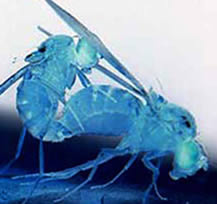
Research
Evolution and Cooperation in Transposable Elements
Why are transposable elements maintained in genomes? Despite thirty years of debate, this question still has no conclusive answer. On the one hand, they may be very effective parasites, replicating themselves at the expense of their host. On the other hand, they can also cause occasionally beneficial mutations. Because of the evolutionary time scales involved, the question cannot be answered with laboratory experiments. Complete DNA sequences of entire genomes are available for many species, and they allow us to ask questions like for multiple transposable element families. The data indicate that in many bacterial species, transposable elements cause the extinction of their host in the long run, and can thus only be sustained by horizontal gene transfer. They can be viewed as extremely slowly acting infectious diseases of cell lineages.
In related work, we analyze the evolution of cooperation in composite transposons. Composite transposons consist of two smaller transposable elements called insertion sequences, which flank the genes that permit such survival. Each insertion sequence in a composite transposon can either transpose alone (“selfishly”) or it can transpose cooperatively, jointly with the other insertion sequence. We examine the conditions under which cooperative transposition is an evolutionarily stable strategy (ESS). These conditions are only rarely met. Our work shows that evolutionary game theory can help understand behavioral strategies of mobile DNA, and that cooperation is a fleeting phenomenon for transposable elements.
These lines of work require us to develop computational tools to study the structure and evolution of transposable elements in many genomes. We apply these tools to discover novel transposable elements in the genomes of various species.
Selected Publications
Bichsel, M., Barbour, A.D., Wagner, A. (2018) Dynamics of an insertion sequence infection in a spatially structured environment. Journal of Biological Systems 26, 133-166. [reprint request] ![]()
Bichsel, M., Barbour, A.D., Wagner, A. (2013) Estimating the fitness effect of insertion sequences. Journal of Mathematical Biology 66, 95-114. [reprint request] ![]()
De la Chaux, N., Wagner, A. (2011) BEL/Pao retrotransposons in metazoan genomes. BMC Evolutionary Biology 11 :154. [reprint request] ![]()
Bichsel, M., Barbour, A.D., Wagner, A. (2010) The early phase of an insertion sequence infection. Theoretical Population Biology 78, 278-288. [reprint request] ![]()
Wagner, A., de la Chaux, N. (2008) Distant horizontal gene transfer is rare for mobile prokaryotic DNA. Molecular Genetics and Genomics 280, 397-408. [reprint request]![]()
Wagner, A., Lewis, C., Bichsel, M. (2007) A survey of transposable elements using IScan. Nucleic Acids Research 35, 5284-5293. [reprint request] ![]()
Wagner, A. (2006) Periodic extinctions of transposable elements in bacterial lineages: Evidence from intragenomic variation in multiple genomes
Molecular Biology and Evolution 23: 723 - 733. [reprint request] ![]()
Wagner, A. (2006) Cooperation is fleeting in the world of transposable elements. PLoS Computational Biology 2(12): e162. [reprint request] ![]()